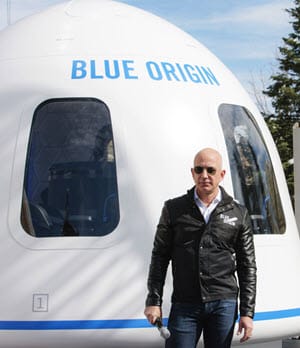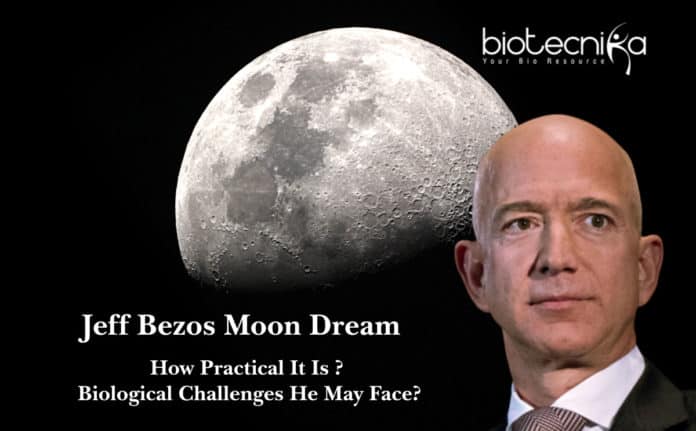Jeff Bezos Moon Dream – How Practical It Is?
Biological Challenges He May Face?
He was just 5 years old when Jeff Bezos first saw the Americans walked on
the lunar surface in the grainy black and white television. Being the one who came up with a brilliant business idea of online shopping portal – Amazon back then in 1994, this man never stopped thinking about the moon. In between handling the shipping, the web servers, the newspapers and groceries this dream of touching the moon never went out of his mind.Jeff Bezos is the man wearing multiple hats and playing a varied role in his leading company Amazon and owning The Washington Post. He also runs a spaceflight company named Blue Origin which interestingly has come up with a giant spacecraft designed to touch the lunar surface having a small rover with eyes like WALL-E. “This is an incredible vehicle,” Bezos said, grinning. “And it’s going to the moon.”
And in case you are surprised to hear this name for the first time that’s because the work conducted by the Blue Origin is secretive and they rarely hold a press event. Bezos spends nearly $1 billion on it each year which he collects from selling off his Amazon stock. Till now Blue Origin has carried out many successful flights on its rocket named New Shepard rock, named after Alan Shepard who was the first American to go into space. The rocket goes upward until it reaches the space and then lands vertically. Bezos wants to fly space tourists as early as this year and with this, another ambitious dream of his is moon which requires different technology.
The beautiful machine is designed to make a landing on the moon which is named as Blue
Visionary Bezos is of the opinion that Earth’s resources are finite and someday they will get depleted. This will result in human species finding or forced to seek other homes. “Space is the only way to go,” Bezos said. So, the plan of Blue Origin is to land a robotic ship which is the size of a small house and which can carry rovers with the help of a rocket engine and soaped up a rocket. It’s that version that could bring people to the moon in the same time frame as NASA’s proposed 2024 return.
He stated: “It’s time to go back to the moon. This time to stay.”
Bezos spacefaring dreams have always been associated with the moon. Hence, he also was a firm believer of the vision put forth by his former professor, the late Princeton physicist Gerald O’Neill. O’Neill envisioned a future with millions of humans living up in space in giant orbiting space cylinders, harnessing the energy of the sun, growing crops. This Physicist theorized that the moon being free of the atmosphere and which is a repository of raw materials with drastic gravitational forces of the earth can act as a staging ground to construct and launch economically efficient habitats. This view of Bezos set him apart from his space-faring tech colleague Elon Musk. Elon Musk visualized planet Mars as humanity’s most suitable Plan B.
“The kids here and their kids and grandchildren will build these colonies. My generation’s job is to build the infrastructure so they will be able to. We are going to build a road to space,” Bezos stated to the audience. “And then amazing things will happen. Then you’ll see entrepreneurial creativity. Then you’ll see space entrepreneurs start companies in their dorm rooms. That can’t happen today.”
But how practical Jeff Bezos dream is from a biological point of view:
While describing how Earth is by far the best planet in the solar system to habitat life and how we should all protect it, but how much is Bezos contributing to this thought really?!
1. Water
Where we are already started facing the water crisis, it’s quite a bigger challenge in front of Blue orbit right now. It has been proved that there is water ice on the surface of the moon at two lunar south and north pole. But it’s still in the frozen form in order to make it in a useable form it needs to be melted and processed which additionally will require even more energy.
2. Gravity
The myth that the moon doesn’t have a gravitational pull is false, it’s just that the moon’s surface gravity is weaker than that of the Earth. In one of the famous episodes from NASA’s Apollo 17 mission in 1972, it can be clearly seen how moonwalker Jack Schmitt fumbles over while collecting a bag which is present on the lunar surface. Mission controller spent a huge amount of time analyzing this video footage to understand why they lost balance and what all techniques they can use as a backup in order to walk upright. Only recently it was found that humans need at least 15 percent of the level of gravity found on earth to orient themselves, and these findings were published in the journal PLOS ONE. And on the moon, there is about 17 percent of Earth’s gravity which is enough to provide cues to understand which way the astronauts should go.
3. Food
In order to cultivate a huge amount of food, a huge amount of energy will be needed to transport it from the earth itself. We haven’t really found a reasonable and reliable source of energy on the moon hence to run this whole habitat consisting of trillions of people, it will be a big challenge to understand and find the source of reliable energy to produce food, to keep the dome working, etc. Oxygen is absent in the space hence it is worth noting down how Bezos will fulfill this huge requirement of oxygen in order to sustain life on the moon.
4. Genetic and immune response
NASA had conducted an experiment called the ‘Twins Study’, in which two astronauts, in reality, who were twin brothers, were kept under observations on how space affects the health. Out of these twins, Mark Kelly, conducted approximately 400 experiments and spent 340 days in space to understand how his body reacted when subjected to extreme conditions at the International Space Station. His twin, Scott Kelly, was considered as a control and remained on Earth in order to understand the difference through comparison.
An interesting finding was Mark’s gene expression and immune system. They found that Mark’s aged slowly as compared to his brother and he could maintain immunity by vaccination. Mark’s gene behaved quite differently in space but was reverted to normal level after spending 6 months back on earth.
5. Can a human baby be born in space?
Although a human-related birth hasn’t experimented so far, in 1983 the Soviet Union had launched a satellite having a pregnant rat on board and they concluded that the trip was harder on the mother than to the fetus. When the babies were brought back to Earth, they were thinner and weaker as compared to their Earth-based counterparts. They also lagged in their mental development which they caught up later. Mother was very much affected who eventually lost a quarter of her body weight and some significant changes in her endocrine and hormonal system. There is a requirement to study this developmental aspect of human development in depth before starting a colony on the moon as it will surely affect the human endocrine system. It will be interesting to see how this aspect will be handled in accordance with Jeff Bezos Moon Dream.
6. Space Sickness
In the absence of Earth’s gravity which weighs down the human body, anyone can get space sickness which is famously called space adaptation syndrome. Very similar to motion sickness but along with this its coupled with disorientation, headaches, vomiting and intense discomfort.
7. Vision Problem
History and almost every astronaut have the experience that their vision starts becoming blur in space. The eyeballs are initially affected and become flat and the retina changes a bit. Statistics states that out of 300 astronauts about 43% experience long term vision problem and 23% experienced short-term vision problem. So be ready if this blue orbit plan becomes a reality, it will affect your vision making it blurred. This happened because when one experience weightlessness the fluid travels to your upper body eventually increasing pressure in your head and crushing your optic nerve a bit.
8. Muscle loss and bone thinning
In space lower body muscles loss sometimes referred to as atrophying, has also been observed. One will also experience a loss in bone density. Such developmental growth defects will eventually lead to stunted growth and development. This is one major challenge that Jeff Bezos needs to study as well.
Jeff Bezos Moon Dream – More then funding, a thorough analysis & planning is required to send people to Mars or the moon and to understand their biological growth aspects which are most important if someone is visualizing a human habitat on any other planet. Along with the utilization of resources, how resources will be made available for sustaining the human colony is another aspect that needs to be kept in the mind.
 she is one of the most active Research enthusiast working with us. Her active interest in various upcoming research in the field of Life Sciences is evident from her articles & Podcasts. This article- Jeff Bezos Moon Dream, is focused on the biological challenges Blue Origin, SpaceX and others may face in their exploration towards outer space.
she is one of the most active Research enthusiast working with us. Her active interest in various upcoming research in the field of Life Sciences is evident from her articles & Podcasts. This article- Jeff Bezos Moon Dream, is focused on the biological challenges Blue Origin, SpaceX and others may face in their exploration towards outer space.






























This article was very useful for me thanku so much